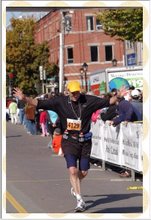Today we are on the third principle of diabetic running, recall that Principle #1 is that you are running for your life and Principle #2 is You need carbohydrates - even sugars. Today we are going to talk about Principle #3 Test strips are cheap running equipment.
We touched on this a bit in Principle #2, the need to keep our out blood sugar in the normal Blood Glucose range. Let me take a moment to put an explanation of what it means to measure your blood glucose level.
"When we speak about measuring blood glucose levels, it can be done two different ways. Blood glucose can be measured randomly from a sample taken at any time (called a "random blood sugar" or RBS). Blood glucose can also be measured in the "fasting" state, meaning that the person has not eaten or taken in any calories in the past 8 hours (usually this is done overnight and it is referred to as an overnight fast and is called a "fasting blood sugar" or FBS). In a person with normal insulin production and activity (a non-diabetic) blood sugar levels will return to "fasting" levels within 2-3 hours of eating. Diabetics (type 1 and type 2) may not be able to get their blood glucose down this quickly after a meal or drinking a calorie-containing drink.Remember, the normal fasting blood glucose level is between 70 and 110 g/dl."
(http://www.endocrineweb.com/diabetes/control.html)
We measure our Blood Glucose using a Monitor, these are an electronic device that when a small amount of blood is placed on a test strip it will give you an approx. Blood glucose level. While the Monitor itself is fairly cheap, the strips are 100$ Canadian a box. Usually a diabetic will test 4 or more times per day. So box will only last 3 weeks at the most. To put that in perspective, there are 18 million Diabetics in the US and Canada Each buying at least 17 box's of strips a year. The makers of these strips are pulling in a whopping 306,000,000,000$(306 Billion) a year just on strips.
Since we know it takes energy to run, and energy is the conversion of carbohydrates to glucose, we have to maintain our blood sugar levels even when we are running. When you first start out I recommend making sure that you test your blood sugar 1 hour before your activity. If you have to snack it will give the food time to digest and start flowing into your system. I find that anything under 10K rate does not really effect my blood sugar levels during a run as long as blood sugar is in the middle of the 70 -110 range.
Where I have to be careful is balancing those longer 10K + runs where we run more then a couple of hours. Since I run 10:1 Run/Walk ration during my LSD not a big issue to stop and test during one of the breaks. I have learned over time where the blood sugar drops is after the run. Yes, it nose dives down very quickly as my muscle now yell to my body to replace the depleted stores of energy.
So make sure you test yourself within 30 minutes of finishing and adjust your food intake accordingly. I have been know to have 1 cup of chocolate milk after a run. It has a good carb to protien ration to help recover from those long runs. I still have to be careful through out the day as the benefit of the run will last all day. Keeping your blood sugar level above 70 is very important as low Blood sugar can cause almost a drunken like state and I have been pulled over by the cops for weaving without having a drink. It happend once honest, thanks to the nice OPP outside of Bracebridge Ontario. Who understood the issue, and sent me on my way after a nice snack.
For those who don't know yes, testing your blood sucks, it hurts on occasion. Imagine sticking yourself with a pin 4 or more times a day in different fingers to make it bleed. They do toughen up but still who wants to go through that every day. Better to watch ourselves while we are healthy. I think tomorrow we will take a step back and talk about The causes of diabetes and how we can help prevent them.
The Diabetic Runner
Harry Jacobs
Wednesday, January 31, 2007
Subscribe to:
Post Comments (Atom)






No comments:
Post a Comment